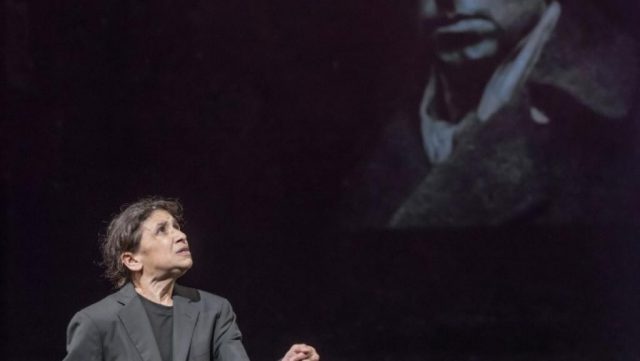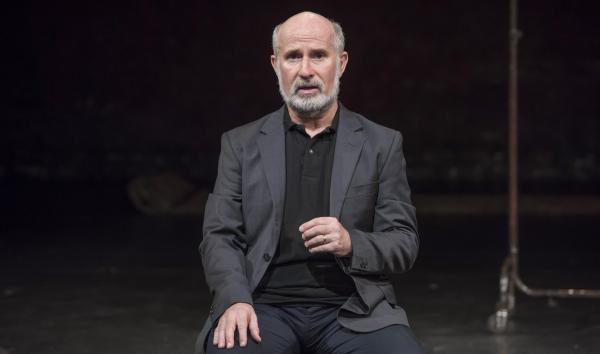
Kathryn Hunter wonders why in Peter Brook and Marie-Hélène Estienne production about theater itself (photo by Pascal Gely)
Theatre for a New Audience, Polonsky Shakespeare Center
262 Ashland Pl. between Lafayette Ave. & Fulton St.
Through October 6, $85-$120
866-811-4111
www.tfana.org
crossingthelinefestival.org
The basic three-letter question “Why?” can be a repeated response, over and over again, from a curious child learning about the world, a deeply philosophical inquiry into human nature, or a painful cry when tragedy occurs. In Peter Brook and Marie-Hélène Estienne’s Why?, continuing at Theatre for a New Audience’s Polonsky Shakespeare Center through October 6, it relates to two queries, general and specific: Why do we make and attend theater, and why did Josef Stalin have theater innovator Vsevolod Meyerhold and his actress wife, Zinaida Reich, brutally killed?
Part of FIAF’s multidisciplinary Crossing the Line Festival, Why? is also the centerpiece of “Peter Brook\NY,” a two-week, two-borough tribute to the ninety-four-year-old theater and film director — he actually prefers being called a “distiller” — an Emmy and two-time Tony winner who has written such books as The Open Door: Thoughts on Acting and Theatre, Tip of the Tongue: Reflections on Language and Meaning, and The Shifting Point: Theatre, Film, Opera 1946-1987 and has directed such plays as Hamlet with Paul Scofield, The Visit with Alfred Lunt and Lynn Fontanne, Marat/Sade, and more recently The Suit, The Prisoner, and The Valley of Astonishment. He is a fixture at TFANA, which is around the corner from the BAM Harvey Theater, which he helped renovate in 1987 for his epic version of The Mahabharata. He and Estienne have been collaborating for more than forty decades, and they know theater.

Marcello Magni gets serious after clowning around in Why? (photo by Pascal Gely)
The first half cheerfully explores why there is theater at all, how it came to be, and what can make it so special. The show begins with Hayley Carmichael, Kathryn Hunter, and Marcello Magni, all dressed in black, giving a kind of master class in acting. Highlights include a clownish Magni running around in circles and Hunter wondering how to make the line “My Lord, the carriage awaits” not boring. They interact with the audience, even bringing a few people onstage for some clever improv, and clearly are in love with their chosen profession, just as we are in love with watching them. There’s lots of laughter, accompanied by Laurie Blundell on piano. Theater appears to be a friendly, safe space for everyone.
But in the second act, the trio, still wearing the same costumes, moving about on the same, mostly empty stage (Brook is known for his spare sets, as evidenced by his seminal book The Empty Space — A Book About the Theatre: Deadly, Holy, Rough, Immediate), the trio becomes far more serious, reading letters, news reports, and other documents relating what happened to Stanislavski protégé Meyerhold and Reich when they supported the communist revolution instead of Stalin, who dealt with them in violent, theatrical ways. The harsh tale also involves actor and director Konstantin Stanislavski and poet Vladimir Mayakovsky. “Theater is a dangerous weapon,” Meyerhold famously wrote in the 1920s. Nearly a century later, it still is; it may be able to entertain, educate, and enlighten us, but it is also seen by far too many as a threat, which Brook and Estienne point out in their inimitable, inestimable way.